
Acleris variegana, the garden rose tortricid moth or fruit tortricid, is a moth of the family Tortricidae. It has a Palearctic distribution. The moth flies from July to September mainly at night and is attracted to bright lights. The larvae feed on various trees and shrubs including rose and apple.

Acleris hyemana is a moth of the family Tortricidae. It is found in Europe.

Acleris hastiana is a moth of the family Tortricidae. It is found in Europe, northern Iran, Kazakhstan, Ala Tau, central Siberia, Irkutsk, the Amur region and China. In North America it is found from the north-eastern United States across southern Canada to British Columbia and south along the Pacific Coast to California.
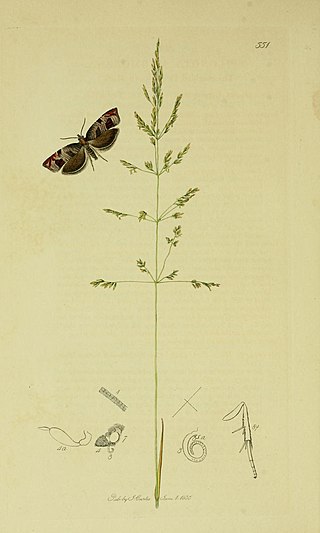
Acleris maccana, the marbled dog's-tooth tortrix, is a moth of the family Tortricidae. The species was first described by Georg Friedrich Treitschke in 1835. It is found from Europe, east across the boreal regions to Siberia. In North America it occurs across much of the boreal forest region, south in the mountains in the east.

Acleris laterana is a moth of the family Tortricidae. It is native to the Palearctic realm, but has been accidentally imported into the United States.

Acleris lorquiniana, the marsh button, is a species of moth of the family Tortricidae. It is found in Iran and central and northern Europe, where it has been recorded from Great Britain, France, Belgium, the Netherlands, Germany, Denmark, Austria, Switzerland, the Czech Republic, Slovakia, Poland, Romania, Hungary, Sweden, Finland, the Baltic region and Russia. The habitat consists of damp fenland.

Acleris abietana, the Perth button, is a species of moth of the family Tortricidae. It is found in Europe, where it has been recorded from Great Britain, Ireland, France, Belgium, the Netherlands, Germany, Denmark, Austria, Switzerland, Italy, the Czech Republic, Slovakia, Slovenia, Poland, Hungary and Russia. The habitat consists of coniferous woodlands.
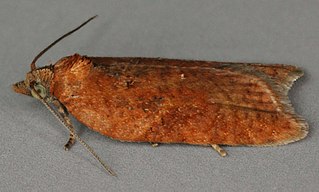
Acleris caledoniana, the Caledonian button, is a species of moth of the family Tortricidae. It is found in Ireland, Great Britain and Poland. It is found in high moorland, where it inhabits mountain bogs.

Acleris fimbriana, the yellow tortrix moth, is a species of moth of the family Tortricidae. It is found in France, Germany, Denmark, Italy, Slovakia, Hungary, Romania, Poland, Norway, Sweden, Finland, the Baltic region, Ukraine and Russia. It is also found in China and South Korea.

Acleris hippophaeana is a species of moth of the family Tortricidae. It is found in France, Belgium, Germany, Austria, Switzerland, Italy, Slovakia, Romania, Russia and on Corsica.
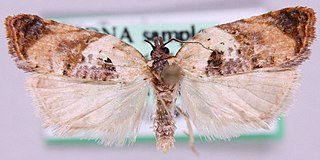
Acleris permutana is a species of moth of the family Tortricidae. It is found in Ireland, Great Britain, Portugal, Spain, France, Belgium, the Netherlands, Germany, Denmark, Sweden, Austria, Italy, the Czech Republic, Slovakia, Slovenia, Croatia, Hungary, Romania, North Macedonia and Russia. The habitat consists of coastal sandhills and limestone.
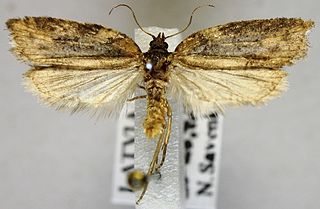
Acleris scabrana, the gray rough-wing moth, is a species of moth of the family Tortricidae. It is found in Europe, where it has been recorded from France, Belgium, the Netherlands, Germany, Austria, Switzerland, the Czech Republic, Slovakia, Poland, Hungary, Romania, Finland, Latvia, Lithuania, Ukraine and Russia. It is also found in Kazakhstan, Tian Shan, Yakutia, Asia Minor and North America, where it has been recorded from Alberta and British Columbia to California.

Acleris shepherdana, the meadow-sweet button, is a species of moth of the family Tortricidae. It is found in Europe, where it has been recorded from Great Britain, France, the Benelux, Germany, Denmark, Austria, Switzerland, Italy, the Czech Republic, Slovakia, Poland, Hungary, Norway, Sweden, Finland, the Baltic region and European Russia. It is also found in the Russian Far East (Ussuri), Manchuria, Mongolia, China and Japan. The habitat consists of fens, marshes, river-banks and other damp areas.

Acleris umbrana is a species of moth of the family Tortricidae. It is found in Great Britain, France, Belgium, Germany, Austria, Switzerland, Italy, the Czech Republic, Slovakia, Poland, Hungary, Norway, Sweden, Finland, the Baltic region and Russia. In the east, the range extends to Japan. The habitat consists of woodland, fens and marshes.
Acleris similis is a species of moth of the family Tortricidae. It is found in Kazakhstan, China, Japan and Russia.
Acleris submaccana is a species of moth of the family Tortricidae. It is found in South Korea, China, Taiwan, Japan, Russia and Central Asia.
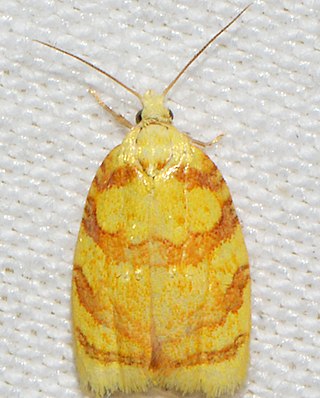
Acleris albicomana, the red-edged acleris moth, is a species of moth of the family Tortricidae. It is found in North America, where it has been recorded from Alberta, Arizona, British Columbia, California, Colorado, Florida, Illinois, Indiana, Iowa, Kentucky, Maine, Manitoba, Maryland, Minnesota, Montana, New Mexico, New York, North Carolina, Ohio, Ontario, Oregon, Pennsylvania, Saskatchewan, Tennessee, Virginia and Utah.

Acleris curvalana, the blueberry leaftier moth, is a species of moth of the family Tortricidae. It is found in North America, where it has been recorded from Alabama, Alberta, Arkansas, British Columbia, Florida, Georgia, Indiana, Kentucky, Maine, Manitoba, Maryland, Massachusetts, Michigan, Minnesota, Mississippi, New Brunswick, New Hampshire, New York, Newfoundland, North Carolina, Ohio, Ontario, Pennsylvania, Quebec, Saskatchewan, Tennessee, Virginia, Washington and West Virginia.
Acleris maculidorsana, the stained-back leafroller moth, is a species of moth of the family Tortricidae. It is found in North America, where it has been recorded from Arkansas, Florida, Georgia, Kentucky, Maine, Maryland, Massachusetts, Michigan, Mississippi, New Jersey, North Carolina, Ohio, Ontario, Pennsylvania, South Carolina, Tennessee, Virginia and Wisconsin.
Acleris minuta, the yellow-headed fireworm or lesser apple leaf-folder, is a species of moth of the family Tortricidae. It is found in eastern North America.
















